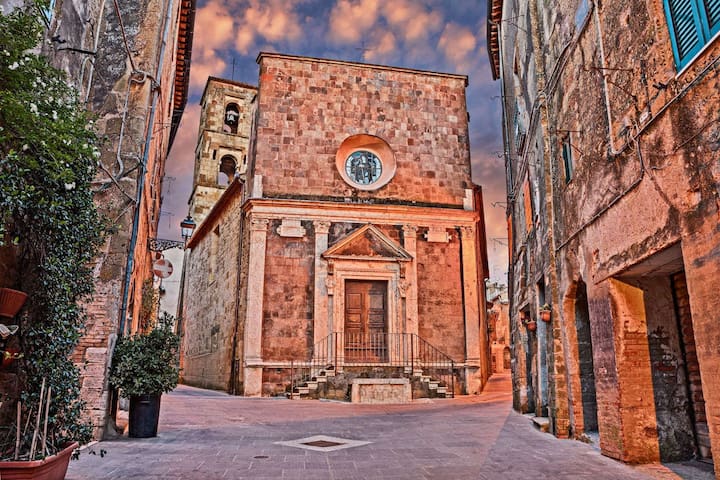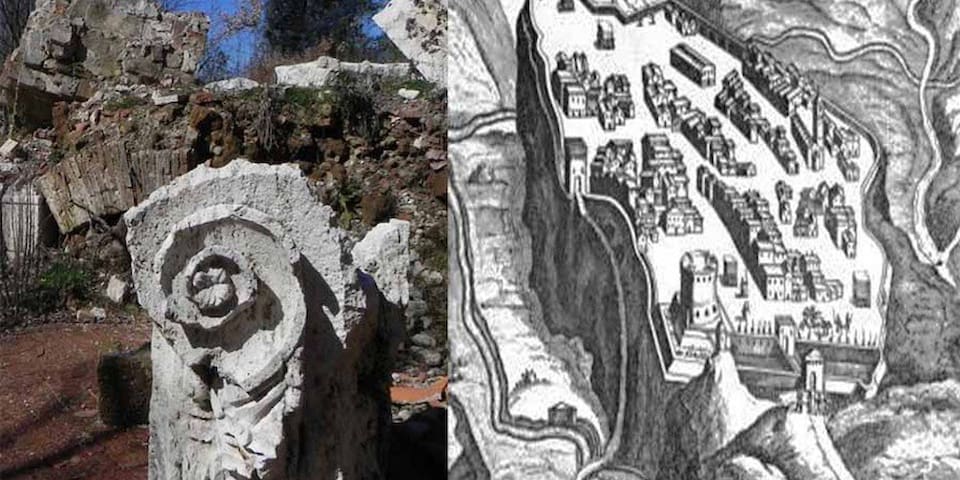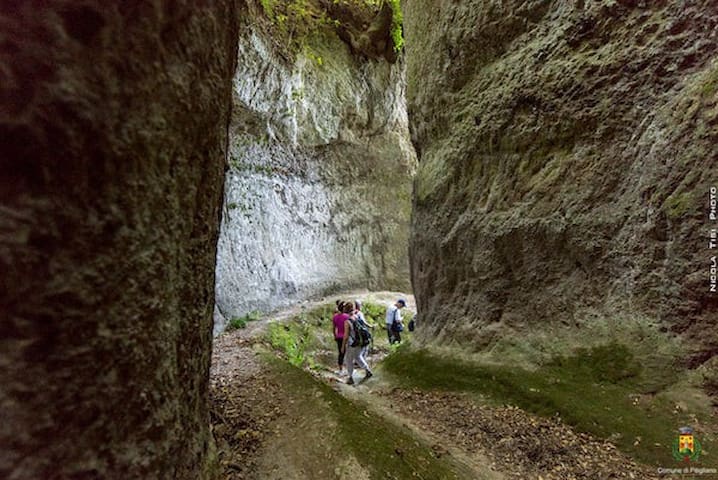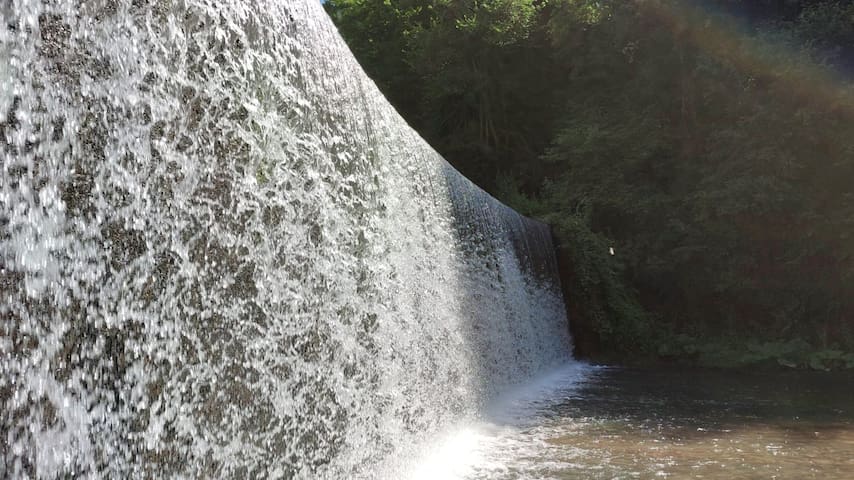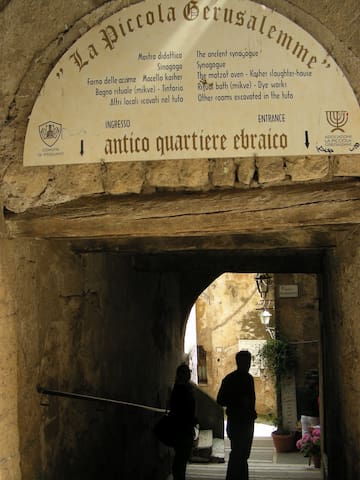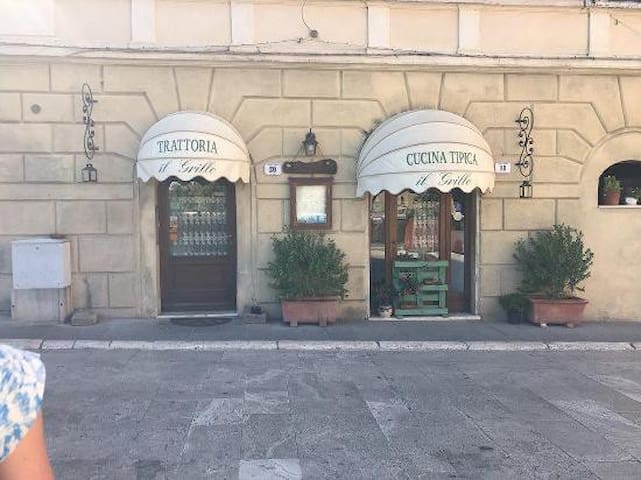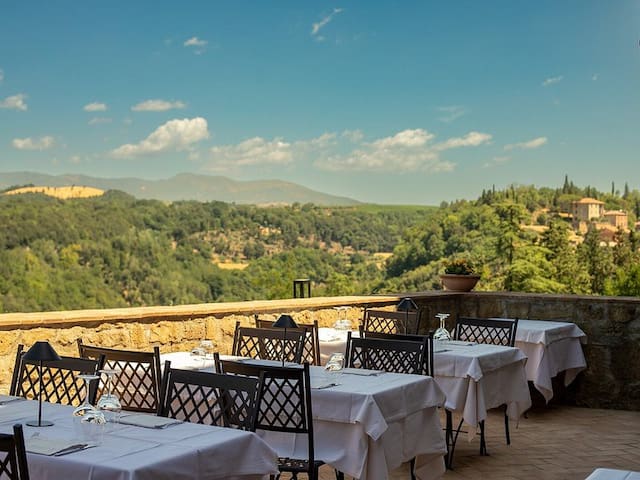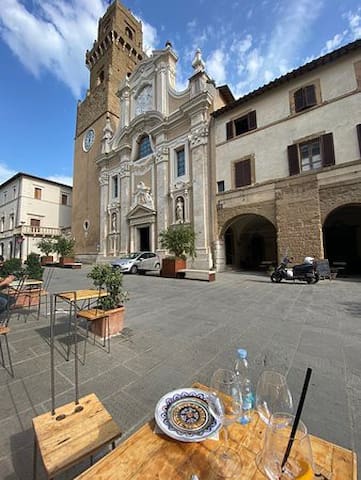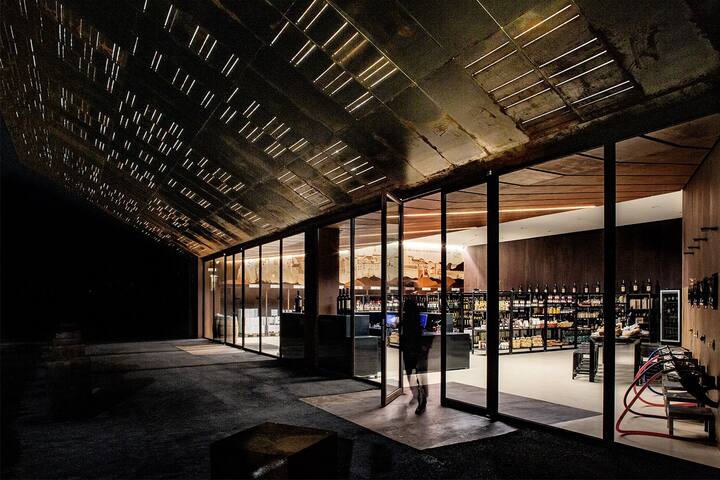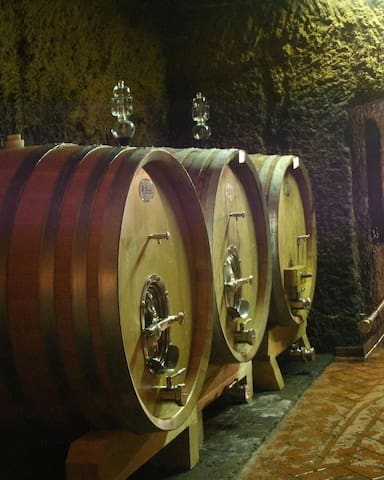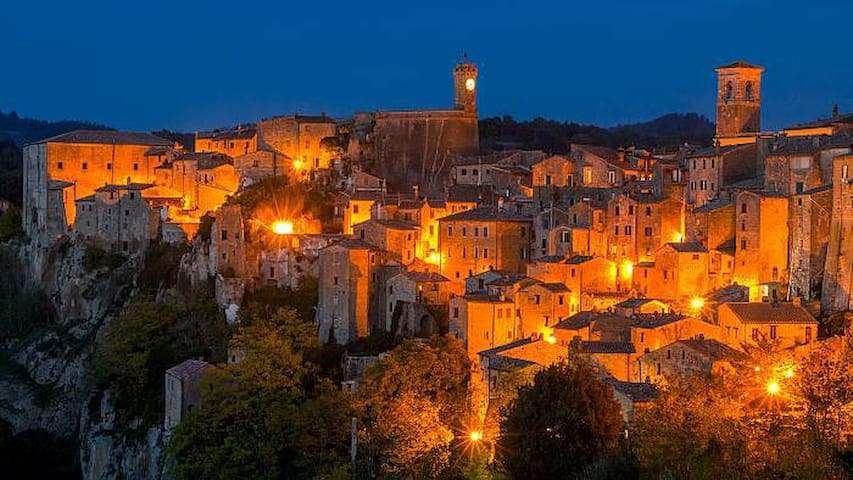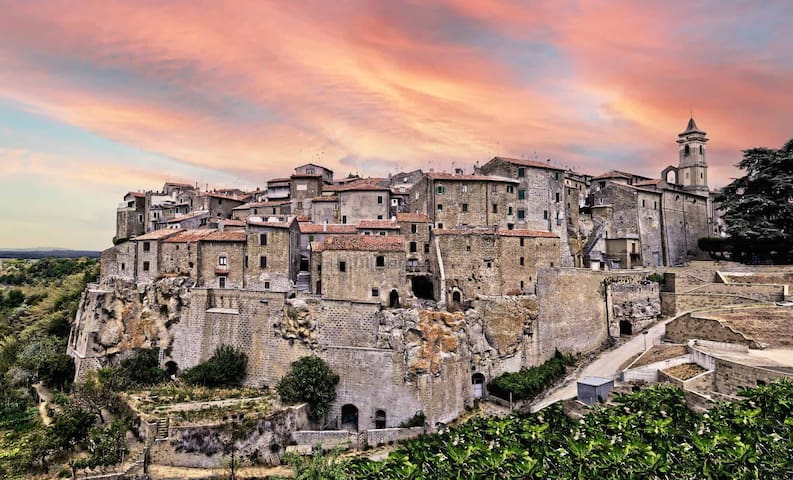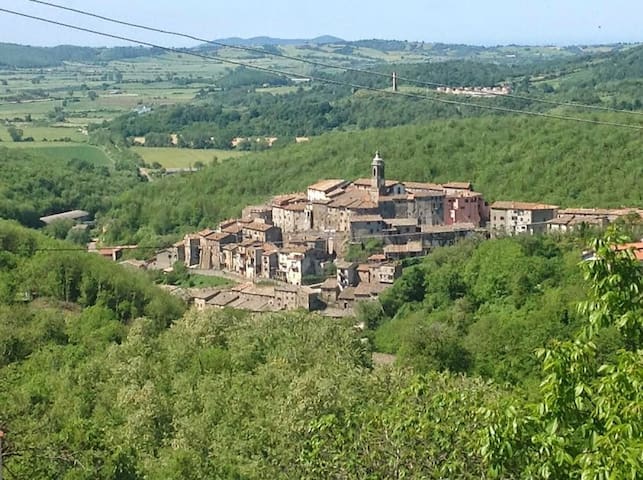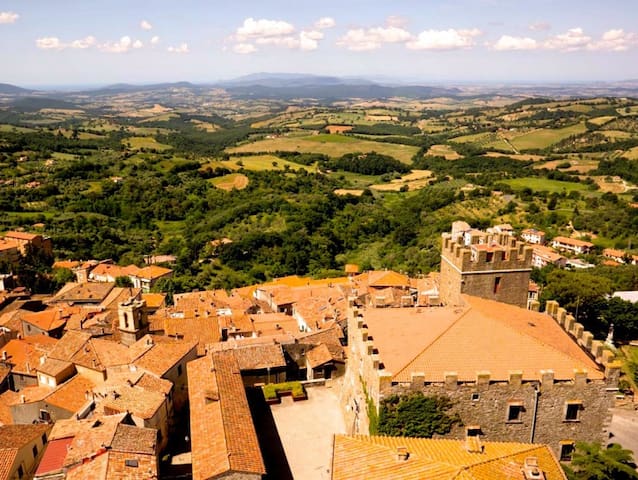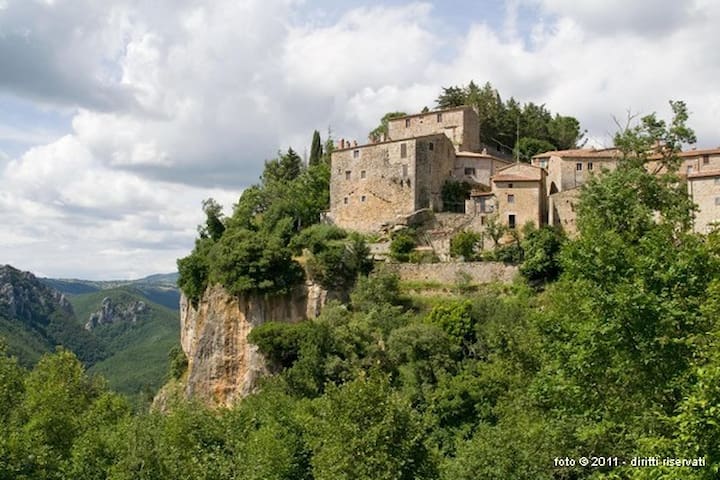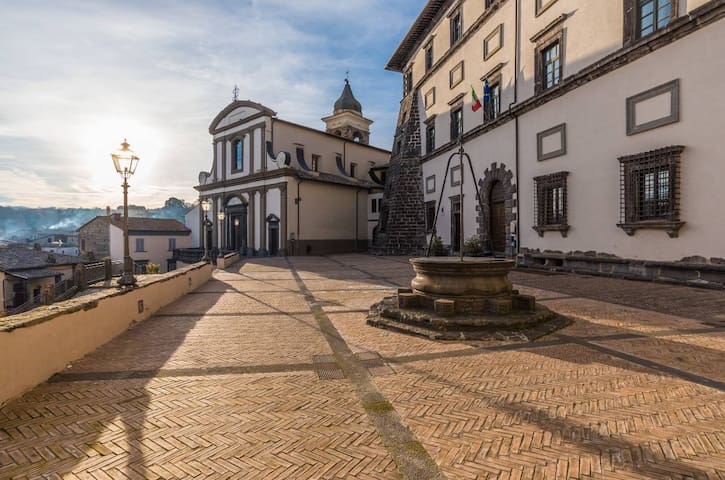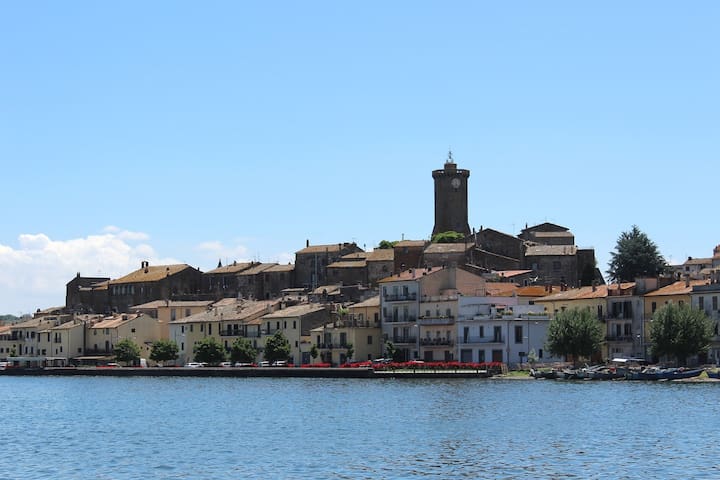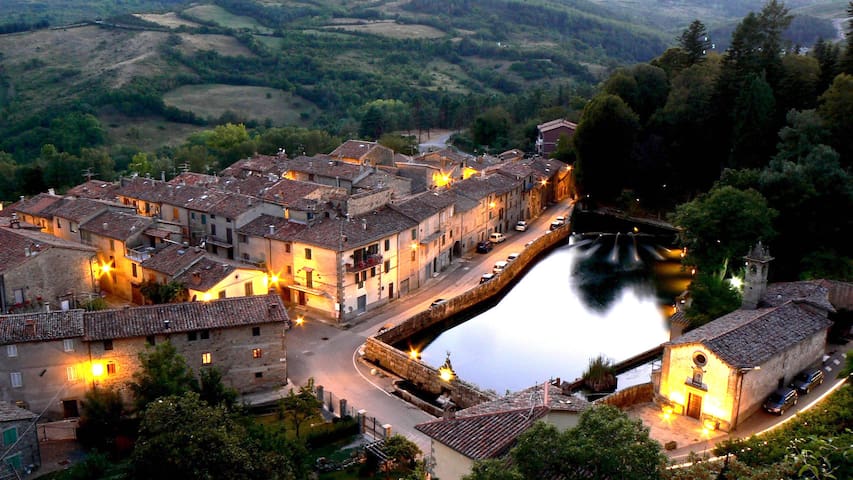Archaeological Sites and Museums in and around Pitigliano
The palace-fortress of the Counts Orsini is one of the most fascinating architectures in southern Tuscany. Born in 1100 as a fortress of the Aldobrandeschi, passed to the Orsini family in 1313. At the end of 1700, owned by the Medici and Lorraine, became the residence of the Bishop of Sovana and then the seat of the central offices of the Diocese. The structure of the building tells centuries of history of the noble families who built and inhabited it: the high tower of the keep, the elegant Renaissance inner square, the frescoed rooms newly restored, with portraits of the Orsini and the zodiac symbols of great historical, cultural and artistic attraction. Since 1989, much of the building was converted into a museum collection of art from both the building itself that the parishes of the Diocese of Pitigliano-Sovana-Orbetello fifteenth and sixteenth-century frescoes, tables and paintings of famous authors, including Guidoccio Cozzarelli, Jerome Welcome, Francesco Zuccarelli; wooden statue of the Madonna and Child by Jacopo Della Quercia and interesting furnishings for liturgical worship.
Suggested duration
1-2 hours
Museo di Palazzo Orsini
25 Piazza Fortezza OrsiniThe palace-fortress of the Counts Orsini is one of the most fascinating architectures in southern Tuscany. Born in 1100 as a fortress of the Aldobrandeschi, passed to the Orsini family in 1313. At the end of 1700, owned by the Medici and Lorraine, became the residence of the Bishop of Sovana and then the seat of the central offices of the Diocese. The structure of the building tells centuries of history of the noble families who built and inhabited it: the high tower of the keep, the elegant Renaissance inner square, the frescoed rooms newly restored, with portraits of the Orsini and the zodiac symbols of great historical, cultural and artistic attraction. Since 1989, much of the building was converted into a museum collection of art from both the building itself that the parishes of the Diocese of Pitigliano-Sovana-Orbetello fifteenth and sixteenth-century frescoes, tables and paintings of famous authors, including Guidoccio Cozzarelli, Jerome Welcome, Francesco Zuccarelli; wooden statue of the Madonna and Child by Jacopo Della Quercia and interesting furnishings for liturgical worship.
Suggested duration
1-2 hours
The archaeological park is divided into two areas: the City of the Living with two didactic models of houses a Bronze Age hut and an archaic Etruscan house, and the City of the Dead with two burial grounds Necropoli Gradone (7th-6th cent. b.C.) and Necropoli S.Giovanni (6th-4th cent. b.C.). The two cities are connected by the Via Cava del Gradone, an ancient path carved in the "tufo" (volcanic rock).
Museo Archeologico Alberto Manzi
Via di PantanoThe archaeological park is divided into two areas: the City of the Living with two didactic models of houses a Bronze Age hut and an archaic Etruscan house, and the City of the Dead with two burial grounds Necropoli Gradone (7th-6th cent. b.C.) and Necropoli S.Giovanni (6th-4th cent. b.C.). The two cities are connected by the Via Cava del Gradone, an ancient path carved in the "tufo" (volcanic rock).
The oldest church in town, dating to the 12th century. The façade is a product of sober late-Renaissance architecture.
Chiesa di San Rocco
Via ZuccarelliThe oldest church in town, dating to the 12th century. The façade is a product of sober late-Renaissance architecture.
The Archaeological Museum is one of the two museums housed in the premises of Palazzo Orsini.
This museum collects and exhibits the finds from the excavation campaigns that took place in the areas of Sovana and Poggio Buco between the end of the 1800s and the early 1900s. The most important collection on display is the one donated by Mrs. Adele Vaselli, with pieces from a campaign. of excavation she financed at Poggio Buco between 1955 and 1960.
The Archaeological Museum of Pitigliano has been part, since 1995, of the Maremma Museums network.
The path winds along six rooms.
Museo Civico Archeologico
1 Piazza della Fortezza OrsiniThe Archaeological Museum is one of the two museums housed in the premises of Palazzo Orsini.
This museum collects and exhibits the finds from the excavation campaigns that took place in the areas of Sovana and Poggio Buco between the end of the 1800s and the early 1900s. The most important collection on display is the one donated by Mrs. Adele Vaselli, with pieces from a campaign. of excavation she financed at Poggio Buco between 1955 and 1960.
The Archaeological Museum of Pitigliano has been part, since 1995, of the Maremma Museums network.
The path winds along six rooms.
The Archeological Park of the “Città del Tufo” showcases the large historical and cultural heritage that exists in the territories of Sovana, Sorano and Vitozza, the so-called tuff areas: a landscape that has remained unaltered throughout history and characterized by the volcanic rock that lends its name to the park.
An area populated by man since the Stone Age and rich in Etruscan-era artefacts, mostly in Sovana: this is where we find the immense Archeological Park, where you can explore monumental Etruscan tombs, including the splendid Ildebranda, Sirena and Demoni Alati Tombs.
10 recommandé par les habitants
parco archeologico città del tufo
The Archeological Park of the “Città del Tufo” showcases the large historical and cultural heritage that exists in the territories of Sovana, Sorano and Vitozza, the so-called tuff areas: a landscape that has remained unaltered throughout history and characterized by the volcanic rock that lends its name to the park.
An area populated by man since the Stone Age and rich in Etruscan-era artefacts, mostly in Sovana: this is where we find the immense Archeological Park, where you can explore monumental Etruscan tombs, including the splendid Ildebranda, Sirena and Demoni Alati Tombs.
In Maremma there is a forgotten city unknown to most, now surrounded by vegetation: the lost city of Vitozza.
Vitozza is a medieval rock settlement located near Pitigliano, the largest in central Italy and part of the Città del Tufo Archaeological Park.
The caves that make up the village were probably inhabited since the Paleolithic, but it reached its period of maximum splendour around the XII-XIV century.
Walking along the paths of the woods, crossing the wonderful meadow that covers the plateau, it is almost impossible to think that once a city stood here. Yet all these cavities are certainly not natural caves. Entering and exploring them, one realizes that centuries of use have modelled them in the form of houses, shops, and workshops.
6 recommandé par les habitants
Insediamento rupestre di Vitozza
In Maremma there is a forgotten city unknown to most, now surrounded by vegetation: the lost city of Vitozza.
Vitozza is a medieval rock settlement located near Pitigliano, the largest in central Italy and part of the Città del Tufo Archaeological Park.
The caves that make up the village were probably inhabited since the Paleolithic, but it reached its period of maximum splendour around the XII-XIV century.
Walking along the paths of the woods, crossing the wonderful meadow that covers the plateau, it is almost impossible to think that once a city stood here. Yet all these cavities are certainly not natural caves. Entering and exploring them, one realizes that centuries of use have modelled them in the form of houses, shops, and workshops.
In the Lazio Maremma, near the border between Lazio and Tuscany, there are the ruins of an ancient city razed to the ground in 1649: Castro. To visit them, you have to go into a dense forest that hides at its feet the foundations and the remains of what, since 1537, was the capital of the Duchy of Castro.
Hidden by the vegetation that, for centuries, has returned to take over the place, the ruins of the ancient capital of the Duchy of Castro lie buried in a dense undergrowth that accentuates the mystery of this lost city. Thus, among brambles, branches and roots of centuries-old trees, you walk among stones and architectural elements of all kinds, frozen in time under a green blanket.
Thanks to the inauguration of the Antica Castro Archaeological Park, which took place on 1 August 2017, many ruins of the city of Castro have been brought to light, as well as restored, and can now be used through a path equipped with signs, which crosses the ancient Renaissance capital.
Antica città di Castro
In the Lazio Maremma, near the border between Lazio and Tuscany, there are the ruins of an ancient city razed to the ground in 1649: Castro. To visit them, you have to go into a dense forest that hides at its feet the foundations and the remains of what, since 1537, was the capital of the Duchy of Castro.
Hidden by the vegetation that, for centuries, has returned to take over the place, the ruins of the ancient capital of the Duchy of Castro lie buried in a dense undergrowth that accentuates the mystery of this lost city. Thus, among brambles, branches and roots of centuries-old trees, you walk among stones and architectural elements of all kinds, frozen in time under a green blanket.
Thanks to the inauguration of the Antica Castro Archaeological Park, which took place on 1 August 2017, many ruins of the city of Castro have been brought to light, as well as restored, and can now be used through a path equipped with signs, which crosses the ancient Renaissance capital.
Must see places in the area (reachable on foot / by bike)
The Vie Cave are unique in the world, a heritage of enormous historical and cultural importance and arouses an irresistible attraction.
They are a few dozen and they vary in size: between two and four meters wide, some of them reach twenty-five meters in height and are up to a maximum of one kilometre long. Walking along these paths gives great suggestions, one has the impression of crossing a fairy-tale world. You enter the earth, between vertiginous walls, mysterious engravings and an enveloping nature with a primordial charm. In some places, the fronds of the trees have created a sort of vegetal roof between the high rock walls, in which the filtering rays of the sun create suggestive plays of light.
if we had to choose some of them for their beauty and charm we would choose Cavone, Via Cava di San Sebastiano, Via Cava di San Rocco and Via Cava dei Fratenuti.
Some suggestions for those who are preparing to visit the Vie Cave: the paths all wind through woods, therefore comfortable shoes or trekking shoes are recommended. It is best to avoid rainy days or days immediately following heavy rains. On hot summer days, remember to bring water to drink. They can be travelled on foot, on horseback and for the more experienced also by bicycle, however, taking into account that there is often moss on the rocks making them slippery and that in some places it is necessary to get off and carry the bike by hand.
Via CAVA di FRATENUTI
269 Strada Provinciale Pian della MadonnaThe Vie Cave are unique in the world, a heritage of enormous historical and cultural importance and arouses an irresistible attraction.
They are a few dozen and they vary in size: between two and four meters wide, some of them reach twenty-five meters in height and are up to a maximum of one kilometre long. Walking along these paths gives great suggestions, one has the impression of crossing a fairy-tale world. You enter the earth, between vertiginous walls, mysterious engravings and an enveloping nature with a primordial charm. In some places, the fronds of the trees have created a sort of vegetal roof between the high rock walls, in which the filtering rays of the sun create suggestive plays of light.
if we had to choose some of them for their beauty and charm we would choose Cavone, Via Cava di San Sebastiano, Via Cava di San Rocco and Via Cava dei Fratenuti.
Some suggestions for those who are preparing to visit the Vie Cave: the paths all wind through woods, therefore comfortable shoes or trekking shoes are recommended. It is best to avoid rainy days or days immediately following heavy rains. On hot summer days, remember to bring water to drink. They can be travelled on foot, on horseback and for the more experienced also by bicycle, however, taking into account that there is often moss on the rocks making them slippery and that in some places it is necessary to get off and carry the bike by hand.
The Vie Cave, sometimes also called Cavoni, constitute an evocative road network of the Etruscan era that connects various settlements and necropolises in the area between Pitigliano, Sovana and Sorano, developing mainly between steep rocky tuff walls, sometimes over twenty meters high: these characteristics also constituted an effective defence system against possible invaders. In Roman times, the Vie Cave became part of a road system that connected to the main section of the Via Clodia, an ancient connecting road between Rome and Saturnia, through the city of Tuscania, which branched off from the Via Cassia in Lazio. The particular microclimate that characterizes the Vie Cave, today makes them an extraordinary ideal habitat for various botanical species, among which numerous types of ferns certainly stand out, such as Scolopendrium Vulgare and Adiantum Capillus Veneris, better known as Capelvenere. In the Pitigliano area, there are many streets that can still be travelled today: the Via Cava di Poggio Cani (the closest to the village), the Via Cava di Fratenuti (the most particular, with walls up to 20 m high), the Via Cava Della Madonna Delle Grazie (which reaches the sanctuary of the same name), Via Cava del Gradone (inside the Alberto Manzi open-air museum, with two Etruscan necropolises), Via Cava di San Giuseppe just beyond the Lente River. The latter, in particular, is among the most evocative streets of the area, as well as being the longest and leads, after passing the Fontana dell'Olmo (an architectural element of which is preserved at the Civic Archaeological Museum of Etruscan Civilization), up to in Sovana. Also in this case an Etruscan necropolis is visible along the route. Finally, this Via Cava is linked to the traditional torchlight procession of San Giuseppe which takes place on March 19th. The link between ancient pagan rites and the atmosphere, which still persists today, of the darkness along the route, dates back to the Christian era, when small niches with painted sacred images, the so-called "scacciadiavoli", were dug in order to protect the wayfarers.
Typology:
Naturalistic
Archaeological - cultural
Type of itinerary:
Trekking
Length:
About 2,5 Km
Travel times:
1.5 hours
Difference in altitude: ↓ + 110 m
Difficulty: medium
Via CAVA ETRUSCA SAN GIUSEPPE
269 Strada Provinciale Pian della MadonnaThe Vie Cave, sometimes also called Cavoni, constitute an evocative road network of the Etruscan era that connects various settlements and necropolises in the area between Pitigliano, Sovana and Sorano, developing mainly between steep rocky tuff walls, sometimes over twenty meters high: these characteristics also constituted an effective defence system against possible invaders. In Roman times, the Vie Cave became part of a road system that connected to the main section of the Via Clodia, an ancient connecting road between Rome and Saturnia, through the city of Tuscania, which branched off from the Via Cassia in Lazio. The particular microclimate that characterizes the Vie Cave, today makes them an extraordinary ideal habitat for various botanical species, among which numerous types of ferns certainly stand out, such as Scolopendrium Vulgare and Adiantum Capillus Veneris, better known as Capelvenere. In the Pitigliano area, there are many streets that can still be travelled today: the Via Cava di Poggio Cani (the closest to the village), the Via Cava di Fratenuti (the most particular, with walls up to 20 m high), the Via Cava Della Madonna Delle Grazie (which reaches the sanctuary of the same name), Via Cava del Gradone (inside the Alberto Manzi open-air museum, with two Etruscan necropolises), Via Cava di San Giuseppe just beyond the Lente River. The latter, in particular, is among the most evocative streets of the area, as well as being the longest and leads, after passing the Fontana dell'Olmo (an architectural element of which is preserved at the Civic Archaeological Museum of Etruscan Civilization), up to in Sovana. Also in this case an Etruscan necropolis is visible along the route. Finally, this Via Cava is linked to the traditional torchlight procession of San Giuseppe which takes place on March 19th. The link between ancient pagan rites and the atmosphere, which still persists today, of the darkness along the route, dates back to the Christian era, when small niches with painted sacred images, the so-called "scacciadiavoli", were dug in order to protect the wayfarers.
Typology:
Naturalistic
Archaeological - cultural
Type of itinerary:
Trekking
Length:
About 2,5 Km
Travel times:
1.5 hours
Difference in altitude: ↓ + 110 m
Difficulty: medium
Very nice little waterfalls next to Pitigliano. Perfect for cooling off from the summer heat. The walk to get there is beautiful.
To get there, do not follow the directions of Google Maps. Instead, use the map of Pitigliano that you find in the apartment. Walk to the end of the historic centre of Pitigliano, go down the steps and then follow the signs for "Cammino del Londini" and "Passeggiata Della Selciata".
Cascate dell'Ondini
Very nice little waterfalls next to Pitigliano. Perfect for cooling off from the summer heat. The walk to get there is beautiful.
To get there, do not follow the directions of Google Maps. Instead, use the map of Pitigliano that you find in the apartment. Walk to the end of the historic centre of Pitigliano, go down the steps and then follow the signs for "Cammino del Londini" and "Passeggiata Della Selciata".
The difference in height and the presence of steep tuff stairs make this route one of the most difficult, even if the effort is rewarded by the beauty of this ancient road.
At the top of the via cava, you can enjoy the marvellous view of Pitigliano and visit the sanctuary of the Madonna Delle Grazie, which dates back to the 15th century. and has always received great devotion from the locals.
Via Cava Madonna delle Grazie
269 Strada Provinciale Pian della MadonnaThe difference in height and the presence of steep tuff stairs make this route one of the most difficult, even if the effort is rewarded by the beauty of this ancient road.
At the top of the via cava, you can enjoy the marvellous view of Pitigliano and visit the sanctuary of the Madonna Delle Grazie, which dates back to the 15th century. and has always received great devotion from the locals.
Pitigliano's neighborhoods
LITTLE JERUSALEM (A visit to Pitigliano's Jewish Quarter)
The Jewish community in Pitigliano grew to an extent that it became known as the “Little Jerusalem”.
Following the papal bulls of 1555-1569, the Jews who lived in the territory of the Papal State were forced to abandon their homes and take refuge in the countryside. Choosing Pitigliano as their new home, they found a welcoming city where they could start their life afresh and create new businesses.
The new Jewish community felt so welcome that they soon built the town’s first sacred building for the Jewish in 1598, the Synagogue.
Later the Jewish Ghetto was created. Today this district features some of the most symbolic buildings of Jewish culture. Along with Synagogue, which is still used, there’s the Butcher Shop, the Cellar, the Ritual Bath and the Forno Delle Azzime bakery, all of which have been transformed into museums (closed on Saturdays).
The Jewish community perfectly integrated into the daily life of Pitigliano and in the following centuries, lived in harmony, even opening flourishing commercial activities.
During the period of German occupation, the city of Pitigliano sided strongly against deportation, many citizens risked their freedom and their life to protect their fellow Jewish citizens. Especially in the countryside, the vast network of solidarity saved many lives. On March 18, 2002, at the Yad Vashem Institute in Jerusalem, the honour of the Righteous Among the Nations was conferred to some Pitigliano families for their heroic deeds in an attempt to save their fellow citizens.
Vicolo Marghera
Vicolo MargheraLITTLE JERUSALEM (A visit to Pitigliano's Jewish Quarter)
The Jewish community in Pitigliano grew to an extent that it became known as the “Little Jerusalem”.
Following the papal bulls of 1555-1569, the Jews who lived in the territory of the Papal State were forced to abandon their homes and take refuge in the countryside. Choosing Pitigliano as their new home, they found a welcoming city where they could start their life afresh and create new businesses.
The new Jewish community felt so welcome that they soon built the town’s first sacred building for the Jewish in 1598, the Synagogue.
Later the Jewish Ghetto was created. Today this district features some of the most symbolic buildings of Jewish culture. Along with Synagogue, which is still used, there’s the Butcher Shop, the Cellar, the Ritual Bath and the Forno Delle Azzime bakery, all of which have been transformed into museums (closed on Saturdays).
The Jewish community perfectly integrated into the daily life of Pitigliano and in the following centuries, lived in harmony, even opening flourishing commercial activities.
During the period of German occupation, the city of Pitigliano sided strongly against deportation, many citizens risked their freedom and their life to protect their fellow Jewish citizens. Especially in the countryside, the vast network of solidarity saved many lives. On March 18, 2002, at the Yad Vashem Institute in Jerusalem, the honour of the Righteous Among the Nations was conferred to some Pitigliano families for their heroic deeds in an attempt to save their fellow citizens.
Via Zuccarelli
Via ZuccarelliPicturesque street with numerous high quality craft shops
The main street of Pitigliano. Perfect for buying some souvenirs, tasting typical local products, sipping an "aperitivo" or having a fantastic dinner at the many restaurants. Or even just for a nice walk, admiring the beauties of the town.
Via Roma
Via RomaThe main street of Pitigliano. Perfect for buying some souvenirs, tasting typical local products, sipping an "aperitivo" or having a fantastic dinner at the many restaurants. Or even just for a nice walk, admiring the beauties of the town.
Restaurants in Pitigliano
Good restaurant, one of the oldest in town. Local cuisine, very well prepared. Good quality-price ratio. We suggest booking in advance.
Trattoria Il Grillo
9 Via CavourGood restaurant, one of the oldest in town. Local cuisine, very well prepared. Good quality-price ratio. We suggest booking in advance.
Upscale restaurant in a gorgeous location. The best seafood restaurant in town. Outdoor tables on the main square have a magnificent views, especially at sunset. They also prepare excellent cocktails.
La Rocca Restaurant
Upscale restaurant in a gorgeous location. The best seafood restaurant in town. Outdoor tables on the main square have a magnificent views, especially at sunset. They also prepare excellent cocktails.
A new entry in town. The spectacular terrace on the valley and the astounding cellar carved in tuff rock alone are worth the visit. Beautifully renovated. Food is a little pretentious and overpriced.
Il Caveau Restaurant Pitigliano
146 Via VignoliA new entry in town. The spectacular terrace on the valley and the astounding cellar carved in tuff rock alone are worth the visit. Beautifully renovated. Food is a little pretentious and overpriced.
Gourmet restaurant with some local plates and some fusion. You can also find fish and seafood dishes. Nice and kind owners.
Dalla Pepita
28 Via RomaGourmet restaurant with some local plates and some fusion. You can also find fish and seafood dishes. Nice and kind owners.
Beautiful location in the main square, good quality, excellent wine list, reasonably priced, friendly owners, and it's just around the corner.
Osteria I’Gazzilloro
Beautiful location in the main square, good quality, excellent wine list, reasonably priced, friendly owners, and it's just around the corner.
Bars and Cafes in Pitigliano
Cute bar in a great location. Perfect place for an aperitivo. Good food too.
Bar Bistrot Le Logge Pitigliano
73 Piazza San Gregorio VIICute bar in a great location. Perfect place for an aperitivo. Good food too.
Great bar in the main square. Good cocktails, and a nice view. A younger crowd in the evenings.
Caffé degli Archi
267 piazza della repubblicaGreat bar in the main square. Good cocktails, and a nice view. A younger crowd in the evenings.
Wine (and olive oil) tastings
Young winery that produces fine quality wines and oil.
Low-impact farming on volcanic soil.
Possibility of tasting in the relax area and other seasonal activities (solarium, wine bar, Taijiquan and meditation).
The cellar can be reached on foot through the trekking route (easy) that the Cavone (Hildebrand Tomb) leads to the archaeological site "La Biagiola", where you can visit the excavation, still in progress, of an Etruscan villa, a Roman house with a small mill and Lombard necropolis.
Ask for further info through their website.
La Biagiola
Young winery that produces fine quality wines and oil.
Low-impact farming on volcanic soil.
Possibility of tasting in the relax area and other seasonal activities (solarium, wine bar, Taijiquan and meditation).
The cellar can be reached on foot through the trekking route (easy) that the Cavone (Hildebrand Tomb) leads to the archaeological site "La Biagiola", where you can visit the excavation, still in progress, of an Etruscan villa, a Roman house with a small mill and Lombard necropolis.
Ask for further info through their website.
The wines produced in Pitigliano are among the most famous in the Tuscan Maremma.
The Cantina Sociale di Pitigliano and the numerous local vineyards produce excellent wines, white and red, following the specification for DOC and IGT. Some vineyards have gone on to win numerous international and national awards.
The wines of Pitigliano are produced with grapes grown exclusively in the territory.
Wine tasting from Monday to Saturday. Please book in advance.
From their website:
" You will be guided to discover our Cellar
where you will learn about the history and the various stages of winemaking; finally, in the showroom, where you can experience our products.
The tasting will be guided by our staff and our oenologist, who will show you the organoleptic characteristics of the wines.
It is possible to book the visit in English."
You can also book through their website.
Cantina di Pitigliano
974 Via Nicola CiacciThe wines produced in Pitigliano are among the most famous in the Tuscan Maremma.
The Cantina Sociale di Pitigliano and the numerous local vineyards produce excellent wines, white and red, following the specification for DOC and IGT. Some vineyards have gone on to win numerous international and national awards.
The wines of Pitigliano are produced with grapes grown exclusively in the territory.
Wine tasting from Monday to Saturday. Please book in advance.
From their website:
" You will be guided to discover our Cellar
where you will learn about the history and the various stages of winemaking; finally, in the showroom, where you can experience our products.
The tasting will be guided by our staff and our oenologist, who will show you the organoleptic characteristics of the wines.
It is possible to book the visit in English."
You can also book through their website.
Wine tastings and visits to the farm and the cellar can be booked on their website.
Sassotondo is a farm born in the Tuscan Maremma, on the southern side of the region; the winery was founded in 1990, when the couple decided to leave behind the activities they carried out to start from scratch and devote themselves totally to agriculture and in particular to the cultivation of Ciliegiolo.
The 12 hectares of vineyards of the Sassotondo winery are developed between the municipalities of Sorano and Pitigliano in the province of Grosseto. The area is considered from a point of view of the altitude as a "hill", but it is a territory that develops as a succession of high lands, interspersed with deep ravines dug into the tuff by discontinuous streams.
Sassotondo was born in the surroundings of what was once the volcanic basin of Bolsena, where tuff is the characterizing material: in fact, vineyards have been planted on terrains with tufaceous soil, and the underground cellar is completely excavated on the tuff.
In the last room of the underground cellar, separated from the rest of the cellar by a long corridor, about 14 meters below the ground and 30 from the entrance, there is the cooper, who enjoys ideal humidity and temperature conditions in a completely natural way.
Since 1994 the Sassotondo winery has followed the methods of certified organic farming, and since 2007 organic farming has been practised in the vineyards.
Sassotondo is a classic farm on which you can come across the Tuscan Maremma, where permanent crops, such as vines and olives, are flanked by arable land, pastures and woods.
From the Bianco di Pitigliano Superiore Bio "Isolina" to the Sovana Rosso Superiore "Ombra Blu", from "Tufobianco" and "Tuforosso" to the expressions of Tuscan Maremma di Ciliegiolo, present in three expressions from cru vineyards, and organic Rosato, scroll down and discover all the organic wines of the Tuscan Maremma offered by the Sassotondo winery.
Sassotondo cantina e vigneti / cellar and vineyards
52 C.s. Pian Di ConatiWine tastings and visits to the farm and the cellar can be booked on their website.
Sassotondo is a farm born in the Tuscan Maremma, on the southern side of the region; the winery was founded in 1990, when the couple decided to leave behind the activities they carried out to start from scratch and devote themselves totally to agriculture and in particular to the cultivation of Ciliegiolo.
The 12 hectares of vineyards of the Sassotondo winery are developed between the municipalities of Sorano and Pitigliano in the province of Grosseto. The area is considered from a point of view of the altitude as a "hill", but it is a territory that develops as a succession of high lands, interspersed with deep ravines dug into the tuff by discontinuous streams.
Sassotondo was born in the surroundings of what was once the volcanic basin of Bolsena, where tuff is the characterizing material: in fact, vineyards have been planted on terrains with tufaceous soil, and the underground cellar is completely excavated on the tuff.
In the last room of the underground cellar, separated from the rest of the cellar by a long corridor, about 14 meters below the ground and 30 from the entrance, there is the cooper, who enjoys ideal humidity and temperature conditions in a completely natural way.
Since 1994 the Sassotondo winery has followed the methods of certified organic farming, and since 2007 organic farming has been practised in the vineyards.
Sassotondo is a classic farm on which you can come across the Tuscan Maremma, where permanent crops, such as vines and olives, are flanked by arable land, pastures and woods.
From the Bianco di Pitigliano Superiore Bio "Isolina" to the Sovana Rosso Superiore "Ombra Blu", from "Tufobianco" and "Tuforosso" to the expressions of Tuscan Maremma di Ciliegiolo, present in three expressions from cru vineyards, and organic Rosato, scroll down and discover all the organic wines of the Tuscan Maremma offered by the Sassotondo winery.
Fattoria La Maliosa is a 160-hectare farm in the Maremman hills made up of arable lands, vineyards, olive trees and forests. It produces natural wines, extra virgin olive oil and honey. Tours, wine and olive oil tastings and horseback riding can be booked online.
Fattoria La Maliosa
Fattoria La Maliosa is a 160-hectare farm in the Maremman hills made up of arable lands, vineyards, olive trees and forests. It produces natural wines, extra virgin olive oil and honey. Tours, wine and olive oil tastings and horseback riding can be booked online.
Other towns and villages to visit
A breathtaking town carved into the Tufo rock, in the heart of the Tuscan Maremma, Pitigliano is one of the most beautiful villages in Italy.
Also known as Little Jerusalem, thanks to the large Jewish community it hosted within its walls in the 16th century, Pitigliano is definitely one for the bucket list next time you’re in Tuscany.
Perched on a cliff of local stone known as ‘tufo’, the town stands majestically at the crossroads of the valleys of the Lente, Meleta and Prochio, with a wonderful view of the wild and unspoiled Tuscan Maremma countryside.
If you’re visiting with your own car, stop at the Sanctuary of the Madonna delle Grazie before entering Pitigliano for a spectacular first view of its spectacular skyline. The massive tufaceous rock supports the entire town, which began as a prehistoric village and blossomed into a modern town.
At night, the view is even more spectacular, illuminated from above by the natural light of the moon, the village seems to be suspended in the void, supported by a mysterious force.
The history of Pitigliano is ancient. Legend suggests the town was founded by two young Romans, Petilio and Celiano, who, fleeing Rome after stealing Jupiter’s golden crown, took refuge in the countryside around Pitigliano, founding the first community from which the city originated, named Petiliano after those two Roman brothers, then becoming, in the following centuries, Pitigliano.
Aside from the legend, Pitigliano can trace its roots farther back than the Roman Empire. The territory was already inhabited in the Neolithic Age. With the arrival of the Etruscans, the Tuscan town was transformed into a veritable city. The Etruscans built the Vie Cave, ancient roads excavated by hand into the tufaceous rock, used as a way of communication and defence and to connect the first villages with the wonderful Necropolis, the Cities of the Dead.
Today Pitigliano is a jewel of art, history and culture, every corner of its Old Town tells a story rich in history. Every narrow alleyway, piazza, panoramic view and museum is one you won’t soon forget.
314 recommandé par les habitants
Pitigliano
A breathtaking town carved into the Tufo rock, in the heart of the Tuscan Maremma, Pitigliano is one of the most beautiful villages in Italy.
Also known as Little Jerusalem, thanks to the large Jewish community it hosted within its walls in the 16th century, Pitigliano is definitely one for the bucket list next time you’re in Tuscany.
Perched on a cliff of local stone known as ‘tufo’, the town stands majestically at the crossroads of the valleys of the Lente, Meleta and Prochio, with a wonderful view of the wild and unspoiled Tuscan Maremma countryside.
If you’re visiting with your own car, stop at the Sanctuary of the Madonna delle Grazie before entering Pitigliano for a spectacular first view of its spectacular skyline. The massive tufaceous rock supports the entire town, which began as a prehistoric village and blossomed into a modern town.
At night, the view is even more spectacular, illuminated from above by the natural light of the moon, the village seems to be suspended in the void, supported by a mysterious force.
The history of Pitigliano is ancient. Legend suggests the town was founded by two young Romans, Petilio and Celiano, who, fleeing Rome after stealing Jupiter’s golden crown, took refuge in the countryside around Pitigliano, founding the first community from which the city originated, named Petiliano after those two Roman brothers, then becoming, in the following centuries, Pitigliano.
Aside from the legend, Pitigliano can trace its roots farther back than the Roman Empire. The territory was already inhabited in the Neolithic Age. With the arrival of the Etruscans, the Tuscan town was transformed into a veritable city. The Etruscans built the Vie Cave, ancient roads excavated by hand into the tufaceous rock, used as a way of communication and defence and to connect the first villages with the wonderful Necropolis, the Cities of the Dead.
Today Pitigliano is a jewel of art, history and culture, every corner of its Old Town tells a story rich in history. Every narrow alleyway, piazza, panoramic view and museum is one you won’t soon forget.
Sorano is an ancient city that flourished in the Etruscan era. Given its position perched on a cliff and dug into the rock (like the nearby Pitigliano), Sorano is also known as the Matera of Tuscany with its rocky villages and charming pathways through the quarries, frequented since the Etruscan period.
Visiting it is like taking a journey through time: a typical and alluring village with all the houses leaning up against the rock, absorbing the unique atmosphere in the picturesque alleys.
111 recommandé par les habitants
Sorano
Sorano is an ancient city that flourished in the Etruscan era. Given its position perched on a cliff and dug into the rock (like the nearby Pitigliano), Sorano is also known as the Matera of Tuscany with its rocky villages and charming pathways through the quarries, frequented since the Etruscan period.
Visiting it is like taking a journey through time: a typical and alluring village with all the houses leaning up against the rock, absorbing the unique atmosphere in the picturesque alleys.
The town of Sovana has, fortunately, maintained its most endearing characteristics, having avoided the Baroque restyling that altered so many churches, monuments and towns in the area. Small in comparison to Sorano and Pitigliano, actually almost tiny, it has managed to retain a charm that is perfect for a quick stroll: the landscape, the food, the wine and the Parco Archeologico Città del Tufo. Particularly suited for those who don’t like walking up and downhill because even though positioned on the hilltop, the town is laid out on a flat plane.
147 recommandé par les habitants
Sovana
The town of Sovana has, fortunately, maintained its most endearing characteristics, having avoided the Baroque restyling that altered so many churches, monuments and towns in the area. Small in comparison to Sorano and Pitigliano, actually almost tiny, it has managed to retain a charm that is perfect for a quick stroll: the landscape, the food, the wine and the Parco Archeologico Città del Tufo. Particularly suited for those who don’t like walking up and downhill because even though positioned on the hilltop, the town is laid out on a flat plane.
Farnese is a small village that rises on a tuff spur surrounded by high cliffs, inhabited since the final Bronze Age (XII-X century BC), in the territory there are traces of Etruscan, Roman and Longobard settlements.
Surrounded by woods and rolling hills, it enjoys an unusual tranquility that is evident when walking through its historic center which reserves corners, passages and alleys that you do not expect.
The atmosphere in these alleys is almost magical, small and graceful courtyards appear at every corner, narrow dead ends, external stairs to access the upper floors of the houses. All with a great abundance of green plants and / or flowers indicating how much the few inhabitants of the historic center love their village. These are contexts now hard to find.
Farnese
Farnese is a small village that rises on a tuff spur surrounded by high cliffs, inhabited since the final Bronze Age (XII-X century BC), in the territory there are traces of Etruscan, Roman and Longobard settlements.
Surrounded by woods and rolling hills, it enjoys an unusual tranquility that is evident when walking through its historic center which reserves corners, passages and alleys that you do not expect.
The atmosphere in these alleys is almost magical, small and graceful courtyards appear at every corner, narrow dead ends, external stairs to access the upper floors of the houses. All with a great abundance of green plants and / or flowers indicating how much the few inhabitants of the historic center love their village. These are contexts now hard to find.
The town is a small village with a typical medieval structure, still perfectly maintained
Surrounded and protected by dense woods that hide it, Latera could escape the less attentive eyes of travelers.
From this peculiarity, it is thought that the name Latera derives from the Latin "latere", meaning to hide.
The landscape surrounding Latera is very suggestive, with views of Lake Bolsena and the nearest lake of Mezzano.
The town is located in the Caldera di Latera, a volcanic formation of great geological importance, which is home to quite rare and unusual species of flora and fauna.
The town boasts an ancient history, with traces and testimonies dating back to 5000 BC, but the village dates back to the Middle Ages, with ancient walls and buildings of the time.
Latera
The town is a small village with a typical medieval structure, still perfectly maintained
Surrounded and protected by dense woods that hide it, Latera could escape the less attentive eyes of travelers.
From this peculiarity, it is thought that the name Latera derives from the Latin "latere", meaning to hide.
The landscape surrounding Latera is very suggestive, with views of Lake Bolsena and the nearest lake of Mezzano.
The town is located in the Caldera di Latera, a volcanic formation of great geological importance, which is home to quite rare and unusual species of flora and fauna.
The town boasts an ancient history, with traces and testimonies dating back to 5000 BC, but the village dates back to the Middle Ages, with ancient walls and buildings of the time.
Manciano is a truly characteristic village, guardian of ancient monuments and the most beautiful panorama of the Maremma, it is certainly a village not to be missed if you are thirsty around southern Tuscany.
Manciano is nicknamed "Maremma Spy", because it offers spectacular views across the Maremma area, from the sea to the mountains, to the Apennines and the islands of the Tuscan Archipelago.
What to see in one day in Manciano?
A day in Manciano will certainly be a unique opportunity to visit this ancient Tuscan village in peace and discover all its most beautiful secrets.
Take Via Marsala, the main street of the town, where there are shops and some of the nicest places, choose one of the characteristic hills and in a short time you will be in the heart of the historic center. Stroll through the alleys of the historic center and discover all the hidden glimpses, the most characteristic alleys and the oldest houses, some of which even today bear plaques that recall their history.
Move to Piazza Garibaldi, where the fountain is located, in Art Nouveau style and built in 1913 to celebrate the arrival of the aqueduct in the town, look upwards and you will also discover the imposing keep ... on the right you will find some delightful gardens and the beautiful panoramic terrace, sit on a bench and contemplate the view of the sea ... a truly wonderful view!
At this point, go up on the keep and, during opening hours, on the panoramic tower, from here you can admire the most beautiful panorama of the Tuscan Maremma, a panorama that makes Manciano famous among the Tuscan villages!
Once you get off, it will probably be lunchtime already ... so why not choose one of the excellent local restaurants?
Go down again towards Via Marsala and choose one of the delicious restaurants you will encounter along your route, elegant bars or typical trattorias, all with a single password: quality! In fact, here all the ingredients are genuine, the dishes are those of tradition, all prepared with care and love.
After lunch, take a nice walk and return to the alleys of the historic center, go up again towards the Cassero and spend a few hours in the Museum of Prehistory and Protohistory. Here, thanks to the help of a tablet, you can enjoy a multimedia experience.
Then go down to the Church of San Leonardo, dedicated to the patron saint of Manciano, the church has medieval origins, was built in 1300, in Romanesque-Gothic style. Inside you can visit some important works of art, including a baptismal font from the 14th century and some paintings by the local artist Paride Pascucci, San Leonardo adora la Sacra Famiglia, from 1894, on Good Friday and one depicting the Apostles, dating back to 1909.
Then return to the town, crossing one of the ancient access gates and admiring the imposing curtain walls, still in excellent condition today.
41 recommandé par les habitants
Manciano
Manciano is a truly characteristic village, guardian of ancient monuments and the most beautiful panorama of the Maremma, it is certainly a village not to be missed if you are thirsty around southern Tuscany.
Manciano is nicknamed "Maremma Spy", because it offers spectacular views across the Maremma area, from the sea to the mountains, to the Apennines and the islands of the Tuscan Archipelago.
What to see in one day in Manciano?
A day in Manciano will certainly be a unique opportunity to visit this ancient Tuscan village in peace and discover all its most beautiful secrets.
Take Via Marsala, the main street of the town, where there are shops and some of the nicest places, choose one of the characteristic hills and in a short time you will be in the heart of the historic center. Stroll through the alleys of the historic center and discover all the hidden glimpses, the most characteristic alleys and the oldest houses, some of which even today bear plaques that recall their history.
Move to Piazza Garibaldi, where the fountain is located, in Art Nouveau style and built in 1913 to celebrate the arrival of the aqueduct in the town, look upwards and you will also discover the imposing keep ... on the right you will find some delightful gardens and the beautiful panoramic terrace, sit on a bench and contemplate the view of the sea ... a truly wonderful view!
At this point, go up on the keep and, during opening hours, on the panoramic tower, from here you can admire the most beautiful panorama of the Tuscan Maremma, a panorama that makes Manciano famous among the Tuscan villages!
Once you get off, it will probably be lunchtime already ... so why not choose one of the excellent local restaurants?
Go down again towards Via Marsala and choose one of the delicious restaurants you will encounter along your route, elegant bars or typical trattorias, all with a single password: quality! In fact, here all the ingredients are genuine, the dishes are those of tradition, all prepared with care and love.
After lunch, take a nice walk and return to the alleys of the historic center, go up again towards the Cassero and spend a few hours in the Museum of Prehistory and Protohistory. Here, thanks to the help of a tablet, you can enjoy a multimedia experience.
Then go down to the Church of San Leonardo, dedicated to the patron saint of Manciano, the church has medieval origins, was built in 1300, in Romanesque-Gothic style. Inside you can visit some important works of art, including a baptismal font from the 14th century and some paintings by the local artist Paride Pascucci, San Leonardo adora la Sacra Famiglia, from 1894, on Good Friday and one depicting the Apostles, dating back to 1909.
Then return to the town, crossing one of the ancient access gates and admiring the imposing curtain walls, still in excellent condition today.
The pretty village of Montemerano is located on a hill between Saturnia and Manciano, surrounded by the Maremma countryside, and protected by three city walls, it has kept intact the medieval aspect with the splendid church, the fortress, the paved streets and the characteristic square. of the castle surrounded by the stone buildings. We suggest a quiet walk through alleys, squares and picturesque views overlooked by small balconies overflowing with flowers.
Piazza del Castello is probably the most characteristic and well-known corner of Montemerano, a square surrounded by historic buildings where time seems to have stopped.
Very beautiful and certainly worth a visit is the Church of San Giorgio, dedicated to the patron saint of the town, known for its frescoes and works of art and the medieval walls.
For some years now, the town of Montemerano has hosted, in the historic building once the nursery school, a wonderful Art History Library, where it is possible to consult almost ten thousand thematic volumes.
All these attractions, the enchanted atmosphere and the many restaurants and wine bars in the town, make Montemerano a stop not to be missed on your holiday in the Tuscan Maremma.
64 recommandé par les habitants
Montemerano
The pretty village of Montemerano is located on a hill between Saturnia and Manciano, surrounded by the Maremma countryside, and protected by three city walls, it has kept intact the medieval aspect with the splendid church, the fortress, the paved streets and the characteristic square. of the castle surrounded by the stone buildings. We suggest a quiet walk through alleys, squares and picturesque views overlooked by small balconies overflowing with flowers.
Piazza del Castello is probably the most characteristic and well-known corner of Montemerano, a square surrounded by historic buildings where time seems to have stopped.
Very beautiful and certainly worth a visit is the Church of San Giorgio, dedicated to the patron saint of the town, known for its frescoes and works of art and the medieval walls.
For some years now, the town of Montemerano has hosted, in the historic building once the nursery school, a wonderful Art History Library, where it is possible to consult almost ten thousand thematic volumes.
All these attractions, the enchanted atmosphere and the many restaurants and wine bars in the town, make Montemerano a stop not to be missed on your holiday in the Tuscan Maremma.
Rocchette di Fazio, an enchanted village where time seems to have stopped.
Off the beaten path, it is definitely worth a little detour if you are visiting Saturnia area. You can include in the visit a short hike to the Albegna river. Semproniano is worth a visit too.
Rocchette di Fazio is a charming and small medieval village located in the municipality of Semproniano, near Saturnia, perched on a cliff overlooking the valleys of the Albegna river and surrounded by unspoiled nature.
Linked to the order of the Knights Templar, it is a country rich in history and millenary legends. It probably already existed before the year one thousand, but took the name of Rocchette di Fazio only after 1291, when the "Lord of the Rocchette" was Bonifazio Cacciaconti known as Fazio.
In the thirteenth century Rocchette di Fazio was one of the main fortresses of Count Aldobrandesca, it then passed under various dominations and in 1536 it was sacked and destroyed by the army of Charles V, remaining for centuries in a state of abandonment.
Since the second half of the twentieth century, it has been the subject of numerous restoration interventions and today it is a real gem of the Maremma that is certainly worth a visit.
14 recommandé par les habitants
Rocchette di Fazio
Rocchette di Fazio, an enchanted village where time seems to have stopped.
Off the beaten path, it is definitely worth a little detour if you are visiting Saturnia area. You can include in the visit a short hike to the Albegna river. Semproniano is worth a visit too.
Rocchette di Fazio is a charming and small medieval village located in the municipality of Semproniano, near Saturnia, perched on a cliff overlooking the valleys of the Albegna river and surrounded by unspoiled nature.
Linked to the order of the Knights Templar, it is a country rich in history and millenary legends. It probably already existed before the year one thousand, but took the name of Rocchette di Fazio only after 1291, when the "Lord of the Rocchette" was Bonifazio Cacciaconti known as Fazio.
In the thirteenth century Rocchette di Fazio was one of the main fortresses of Count Aldobrandesca, it then passed under various dominations and in 1536 it was sacked and destroyed by the army of Charles V, remaining for centuries in a state of abandonment.
Since the second half of the twentieth century, it has been the subject of numerous restoration interventions and today it is a real gem of the Maremma that is certainly worth a visit.
Gradoli, stands on a tufaceous hill at 475 meters above sea level in the heart of the Volsini Mountains, mostly surrounded by the Fosso Rigo stream. Gradoli presents itself to the visitor as a suggestive and graceful village, surrounded by woods and moats, where the mighty Rocca Farnese stands out.
Gradoli
Gradoli, stands on a tufaceous hill at 475 meters above sea level in the heart of the Volsini Mountains, mostly surrounded by the Fosso Rigo stream. Gradoli presents itself to the visitor as a suggestive and graceful village, surrounded by woods and moats, where the mighty Rocca Farnese stands out.
The town lies on the western shore of Lake Bolsena and is certainly one of the jewels of the upper Tuscia of Viterbo. Its historic center will enchant you with its order and geometric perfection. This is because each tuff house is well placed and embellished with beautiful plants that give color to the stone alleys. The lakeside promenade is also wonderful and I recommend that you go all the way from the La Cava beach to the marina.
Marta also has two municipal beaches, to the delight of all lovers of the waters of the lake. The "Spiaggia di Marta" can be reached at the end of the promenade along the lakeside of Montefiascone, along Via della Spiaggia, about 1 km from the historic center of the village.
The other beach is located in the western part of Marta, near the Borgo dei Pescatori. It is called "Cava" and is more reserved. Both are free to enter.
21 recommandé par les habitants
Marta, Lazio
The town lies on the western shore of Lake Bolsena and is certainly one of the jewels of the upper Tuscia of Viterbo. Its historic center will enchant you with its order and geometric perfection. This is because each tuff house is well placed and embellished with beautiful plants that give color to the stone alleys. The lakeside promenade is also wonderful and I recommend that you go all the way from the La Cava beach to the marina.
Marta also has two municipal beaches, to the delight of all lovers of the waters of the lake. The "Spiaggia di Marta" can be reached at the end of the promenade along the lakeside of Montefiascone, along Via della Spiaggia, about 1 km from the historic center of the village.
The other beach is located in the western part of Marta, near the Borgo dei Pescatori. It is called "Cava" and is more reserved. Both are free to enter.
The town of Santa Fiora, in the province of Grosseto, is part of the club of the most beautiful villages in Italy thanks to its tourist, environmental and historical-cultural qualities.
Santa Fiora recently received the orange flag by the Touring Club, that rewards sustainable tourism and environmental protection.
Visit the historic center, whose heart is Piazza Garibaldi, overlooked by the clock tower, Palazzo Pretorio and Palazzo Sforza Cesarini, and don't miss the parish church of Saints Flora and Lucilla, dating back to 1142.
Down the road you come to gardens and the oratory of Chiesa della Madonna della Neve, (its façade is decorated with a beautiful alfresco of Saint Fiora and Lucille) and then to the village's nicest feature, the Peschiera, a spring-fed lake and 18th-century garden surrounded by woodland and gurgling brooks.
38 recommandé par les habitants
Santa Fiora
The town of Santa Fiora, in the province of Grosseto, is part of the club of the most beautiful villages in Italy thanks to its tourist, environmental and historical-cultural qualities.
Santa Fiora recently received the orange flag by the Touring Club, that rewards sustainable tourism and environmental protection.
Visit the historic center, whose heart is Piazza Garibaldi, overlooked by the clock tower, Palazzo Pretorio and Palazzo Sforza Cesarini, and don't miss the parish church of Saints Flora and Lucilla, dating back to 1142.
Down the road you come to gardens and the oratory of Chiesa della Madonna della Neve, (its façade is decorated with a beautiful alfresco of Saint Fiora and Lucille) and then to the village's nicest feature, the Peschiera, a spring-fed lake and 18th-century garden surrounded by woodland and gurgling brooks.

